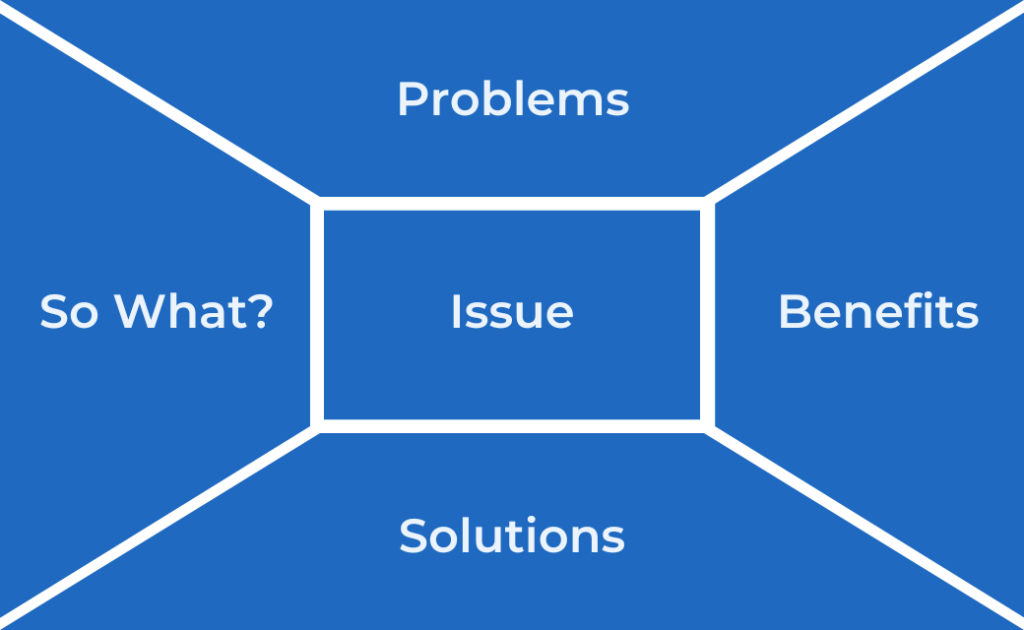The Message Box: A Powerful Tool for Communicating Science
Many communications professionals in the post-secondary sector share a common challenge: Communicating complex science.
Sharing the intricacies and significance of scientific research with a broad audience or even just your student press can be a daunting task, but it’s important.
That’s why we wanted to share with you a unique tool we’ve come across and found quite helpful.
It’s called the Message Box, and it was developed by an organization called COMPASS which is dedicated to communicating science.
This tool is designed for practicality. You can use it to distill complex information into clear, engaging, and relevant messages tailored to specific audiences.
What follows is an overview, but we encourage you to visit the COMPASS website if you want to dive deeper and really transform your science communication efforts.
What is the Message Box?
The Message Box helps scientists—and the communications professionals who work with them—organize their thoughts and identify key points of their research that will resonate with different audiences.

It consists of five sections:
- Issue
- Problem
- So What?
- Solution
- Benefit
This structured approach helps you sift through vast amounts of information and highlight what’s most important and relevant for the audience.
Why Use It?
Traditional scientific communication is often done peer-to-peer—it’s scientists talking to other scientists. So, it tends to involve detailed and technical presentations, with lots of jargon and assumptions that the audience has a certain foundation in the language and concepts being used.
However, this approach is less effective for non-scientific audiences, including journalists. They usually don’t have the background to appreciate the finer details. The Message Box addresses this gap by helping you and the researchers you work with:
- erepare for interviews
- explain the work in a way that is meaningful to various audiences, from journalists to policymakers
The Sections of the Message Box

Let’s go into those sections in more detail.
- Issue: This central section identifies the overarching topic of the research in broad terms. It sets the stage for the rest of your messaging and should be concise and clear. Think of it as the big-picture context of the work.
- Problem: Here, you narrow down to the specific aspect of the issue that the research addresses. This section reflects the researcher’s expertise and the unique contribution of their work.
- So What?: This is perhaps the most critical part of the Message Box. It answers why your audience should care about the research. It translates the significance of the work into terms that matter to the audience, highlighting the impact and relevance of the findings.
- Solution: Outline the possible solutions to the problem that the research has illuminated. This section should be actionable and relevant to your audience, providing clear steps or recommendations based on the research. It’s the call to action.
- Benefit: Finally, describe the positive outcomes that will result from implementing these solutions. This section ties back to the “So What?” by focusing on the tangible and beneficial impacts of the research.
Practical Tips for Using the Message Box
- Know Your Audience: This part is really important. You need to tailor your message to the interests, values and needs of the audience. If you’re working in public relations or media relations, the general public is who you should have in mind here. But the Message Box is a versatile tool and your researchers may want to create different Message Boxes for different groups.
- Iterate and Refine: The first draft of your Message Box is rarely the final one. It’s an iterative process that improves with feedback and practice.
- Avoid Jargon: Use simple, clear language that is accessible to non-experts. Avoid technical terms that might alienate your audience.
- Make It Memorable: Use anecdotes, metaphors and soundbites to make your message engaging and memorable. Support your points with data but limit the amount to avoid overwhelming your audience.
The Message Box is a valuable tool for any communicator looking to make scientific research more accessible and impactful. By breaking down complex information into manageable, audience-specific messages, the Message Box will help you communicate effectively with the general public, or any number of stakeholder groups. Embrace this tool to help the bright minds at your institution share the significance of their work with the world.
Receive our newsletter
Sign up below and we’ll be in touch with monthly updates about Broadsight, along with news and insights to keep you on the cutting edge of communications work in an AI era.

